
The Revived Tarot
Obscuring the Origins and Contaminating the Sources
The Problem of the Fool The earliest Tarot were often un-numbered and considerable variation existed in the sequence of the Trumps. By the 16th Century, while the Tarot order was still subject to variation, the Fool was always un-numbered and sometimes untitled and placed usually first or occasionally last. The Tarot de Marseille, the source for the French and then English occultists, places the un-numbered Fool first. Eliphas Levi "improved" on the Tarot de Marseille by placing the Fool as an un-numbered key between 20 and 21. Once one recognizes (as Levi did) that the Tarot = Hebrew letters, then the obvious problem is to find a place for the Fool and to give it a number from 1 to 22. The Distortion of the Zero Key After accepting Levi's equation of the 22 Tarot with the 22 Hebrew letters, the mathematically-challenged Order of the Golden Dawn decided that no-number = zero and re-initialized the Fool -- not as 1, but as "0." This yielded Macgregor Mathers' "supreme magickal formula"
which has to be one of the most over-rated "supreme magickal formulae" ever formulated. Unless the object is mystification. The only reason to introduce the notion of a "zero" key, when there are obviously twenty-two of them and they obviously correspond to the letters of the Hebrew alphabet, which already have perfectly good numbers, starting with "one", is to break the connection with the true, underlying tradition. Aleister Crowley's version of this was "Aleph is one, one, one, but none by the book." The alludes to Aleph's gematria of 111, but claims that in the "book" of the Tarot, Aleph is zero, not one. After first accepting the inescapable conclusion, Levi's premise that 22 Tarot = 22 Hebrew letters, the significance is rejected by reinterpreting the Hebrew alphabet. Which, apparently, English "gentlemen" could do, unchallenged, in the 19th century -- "it means one thing, one, in Hebrew, and another thing, zero, in the Tarot. These two things, one and zero, are actually the same." For those literate in either Hebrew or Mathematics, these formulations seem like foreign artifacts in their native languages. Introducing Arabic (Indian) mathematical concepts like place-value and zero creates an "off-by-one" error that only serves to obscure the roots of the Tarot in the Hebrew letter-numbers and the formulations of the Kabbalah and classical formative numerology. Thus, "Key 1" is supposed to be the Magician and is also supposed to correspond to the letter Bayt/Beth, which has the numerical value of 2. And so on, solely for the sake of confusion and obfuscation. See: Traditional Tarot. Today, we would call this a thought disorder:
Actually, it isn't. The High Priestess is the End of the Alphabet. Ignoring the Hebrew Alpha-Numerical Structure The final step was to remove the Fool from the sequence entirely, putting it at the top of three rows of seven cards, breaking the vertical correspondences of related letters, like Aleph, Yod and Qof (1.10.100) or Bayt, Kaf and Raysh (2.20.200). The natural sequence of the Tarot mirrors the letters they represent, in three rows of nine with the last five optionally filled in with their final (sofit) forms. Seven columns makes no sense in the context of the Hebrew alphabet because the letter-numbers are numbered 1-9, 10-90 and 100-900. Destroying the Natural Order
The unfolding and sequential development of the planets and zodiac in the Sepher Yetsira, and their corresponding alphabetic position and Hebrew formative letters are all part of a interrelated whole specifying the development and interaction of impersonal energies (planets) in active environments (signs). The zodiac begins with Aries/Toleh, formed by Hay, [5], and ends with Pisces/Dagim, formed by Qof, [100]. The planets begin with Saturn/Shabatai, formed by Bayt, [2], and end with Moon/Lavanah, formed by Tav, [400]. After Aleph, the formative sequence unfolded by the Sepher Yetsira begins with Saturn, Jupiter and Mars, corresponding to the second, third and fourth letter and the fifth, sixth and seventh sephirot. This is the logical and classical Western sequence of manifestation, moving in from the outermost classical planet. It reflects the pairings of the planetary binomials in the sephirot and cube of space which are in sequence in the alphabet. It is understandable that the Golden Dawn could play fast and free with Jewish tradition, but they also did violence to the entire tradition of classical understanding and pre-nineteenth century western mysticism: 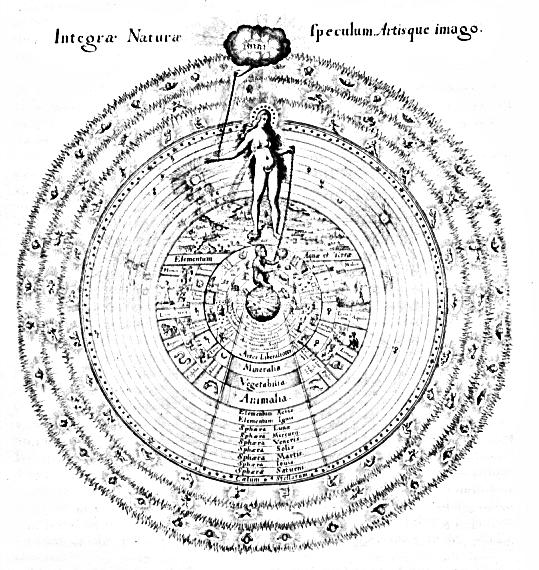
Fludd: Integrae Naturae 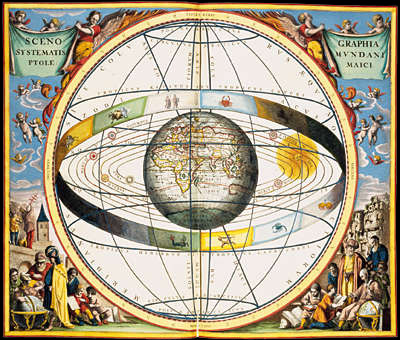
Ptolemy The Golden Dawn changes the traditional initiating sequence of outer planets to Mercury, Moon and Venus, in order to justify the positions of the Magician, High Priestess and Empress. For the remaining planets, the classical Hebrew and Ptolemaic sequence of Sun, Venus, Mercury and Moon -- moving in from the Sun and through the alphabet (Adam Kadmon sees Mercury as the 9th Sephira and Venus the 10th) -- is discarded for Jupiter, Mars, Sun, and Saturn. The logical sequence of the outer and inner planets moving in towards the Moon is replaced with a hopscotch pattern. 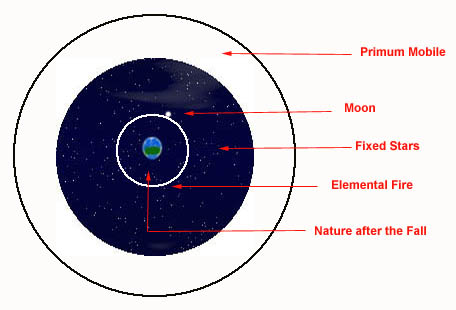
Medieval Model It appears that only the compartmentalized state of "esoteric knowledge," coupled with a general ignorance of both classical tradition and Hebrew sources, permitted the rearranging of the "spheres of the heavens" into the hodgepodge of the Golden Dawn system. However, the Golden Dawn were not the first to monkey with the classical sequence; the Rosicrucians had already switched the Moon and the Sun to put the Sun at the center of the six-pointed star, probably under the influence of Christian solarization. This arrangement shows up in later "magical" systems when assigning planets to the Star of David (not realizing its underlying structure, the Cube of Space). 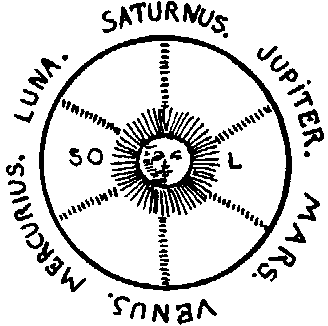
Both hide the crucial truth of the Moon's position at the center of our Psyche: 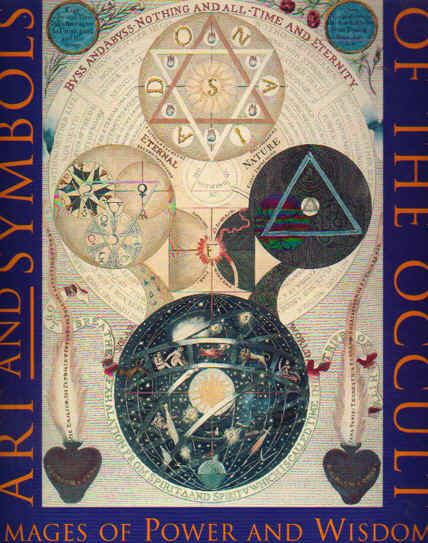
Tree of the Cosmos Boehme [Jacob Behmen] The Phony Egyptian Overlay The story begins and ends in pure fantasy on the part of all the participants. As Decker notes, The Court de Gebelin didn't let living in pre-Rosetta Stone France stop him from deciphering the letters TARO as Egyptian hieroglyphs.
Where have we heard syntax like that? The theme was taken up over the years (the occult speculators were primarly French, until the English arrived on the scene with a fake passport). The French word for trump, atous, was metamorphosized into an egyptianate ATU and a thin overlay of mythology added, without explaining why there are twenty-two of these "Egyptian" archetypes. Crowley is the pinnacle of this achievement. Follow the development of the idea in the History of Egyptian Tarot and Egyptomania—How Tarot Became Egyptian. It is easy to read Tarot commentary and history as a massive defense, characterized by avoidance (foreclosure of the signifier) and hallucinatory rationalization, against the language of the Other. An author will "uneasily" acknowledge the fact that there are twenty-two trumps and twenty-two Hebrew letters, and then move away in some other direction, lacking a means to stay with the central, selected fact. The extremes of this defensive process in the Western psyche in modern times has made the Crusade against the Cathars look like small potatoes, and is why the language of the Other (and God) in the West is Hebrew and has twenty-two letters in its alphabet. And why the Tarot was encoded in the first place. The Gra Version of the Sepher Yetsira This is not really a problem, except when variations between versions result in "improvements" on a received tradition by outsiders. There are four primary versions of the Sepher Yetsira, Saadia's, the Short, the Long, all from the 9th and 10th centuries, and the Ari-Gra, a late medieval recension in accord with Lurianic theosophy. There are some differences between the texts, particularly considering the Short version is half the length of the Long. The Gra version, for instance, specifies different planets for all seven double letters in comparison to the others. One of the Golden Dawns's rationalizations for changing the planet "erupting from the letter" was that there was too much confusion in the Hebrew source text, the Sepher Yetsira, which they had in translation by Westcott, supposedly around the seven double letters. What this confusion was one can only imagine. As a result, the Golden Dawn and their followers accepted all of the zodiacal and none of the planetary correspondences of the Gra version. Their sources and quality of scholarship is assessed in Brian Dobb's commentary on the Sepher Yetsira. The Gaon of Vilna, known as the "Gra", published a version of the Sepher Yetsira in the late 18th century based on Isaac Luria's interpretations a hundred years before. This version has been popular, particularly in Hasidic circles and among Western esoteric commentators, even though it is a late redaction intended to reconcile the Sepher Yetsira with the Zohar and Luria's cosmology, itself a radical departure from ancient and classical cosmology and geocentric astrology. Aryeh Kaplan, a Jewish Rabbi who wrote a translation and commentary on the Sepher Yetsira, perferred the Gra version. His views (as representive of post-Zohar commentary) have generally been uncritically accepted:
"Highest Hebrew authority ... as the original and extraordinarily ancient bedrock of Western Esoteric Tradition" ... since at least the 18th century. See Kaplan's analysis of Wondrous paths. Generally, when assessing an ancient text, earlier versions are preferable to redactions made one or two thousand years later, but everyone to their preference. The exercise of trying the Gra attributions is left as another experiment for the reader. From the Golden-Dawn perspective, the Gra puts the High Priestess (Moon) on Bayt and the Magician (Mercury) on Pay, which is probably why they didn't use the Gra version either. It should be noted that Tarot decks supposedly constructed on the Gra version actually just use the Golden Dawn Hebrew letter-Arcana correspondences and paste the Ari-Gra planetary/zodiacal assignments on top (El Gran Tarot Esoterica, Tarot for the Ages). Payne-Towler seems to confuse the Lurianic Cube with the Ari-Gra Tree of Life and the Golden Dawn trans-Saturnian planetary placements in her Spanish School letter-arcana assignments (Mem=Nepture, Tav=Fire). See: the Lurianic Cube of Space. Back | Contents | Next
| ||||||||||||||||||||||||||||||||||||||||||||||||||||||||||||||||||||||||||||||||||||||















